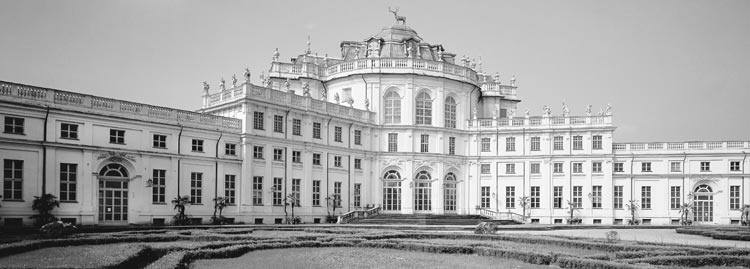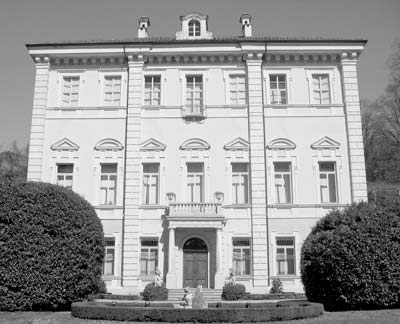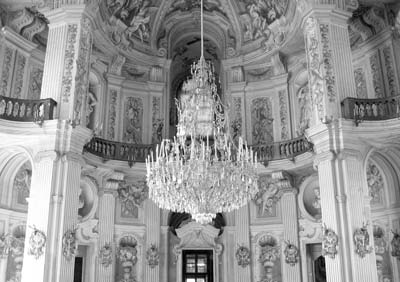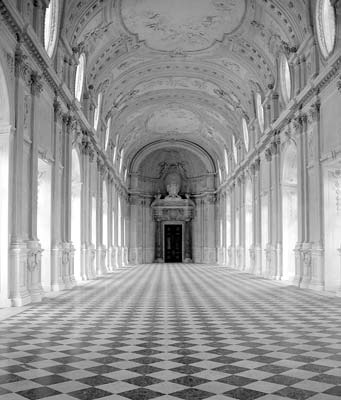Italy — Visiting the villas of Piedmont
by Jim Sajo, Polcenigo, Italy
If you are like me, after seeing the passion of the 2006 Winter Olympics in Turin you wanted to jump on a plane for the Piedmont region in northwest Italy. Great idea, but, without Olympic action, what should you do there? My advice is to see the area’s magnificent villas, remnants of the Savoy family dynasty.
A bit of background
A ring of royal residences of enormous historical and architectural value surround Turin. These masterpieces are a remembrance of warrior kings who were great collectors of art. They are the work of architects, sculptors and painters who tested the limits of their craft. They are homes designed by royal women who loved ballet, theater and sumptuous gardens.
When Emanuele Filiberto, the Duke of Savoy, moved his capital to Turin in 1562, he launched a vast series of building projects. His successors continued the process, either creating new palaces or renovating old ones.
The impressive complex of buildings, designed and embellished by leading architects and artists of the time, radiates out to the surrounding countryside. Twenty-two royal structures are designated as World Heritage Sites by UNESCO. (For an explanation of what that means, read the terrific article by Arline Wills [Jan. ’06, pg. 26].)
Here is a look at five of the most impressive.
Rivoli Palace
Reachable by bus No. 36 from downtown Turin, Rivoli Palace sits high upon a hill overlooking the entrance to the Susa Valley (the site of Olympic ski events). It was built as a defensive stronghold in the 11th century, and the military force stationed there controlled the passes from France as well as the plain where Turin lies. Today, visitors enjoy stunning views from its hilltop location.
Upon their arrival, the royal family redesigned and enlarged the fortress. The varied architectural styles of the exterior and the eclectic art collection inside reflect their changing tastes over the years.
As is the case with many of the important villas, Rivoli fell into decay and limited use in the late 19th and early 20th centuries. During World War II, Germans occupied it as a military headquarters, inflicting serious damage upon their exit.
Today, the rebuilt palace boasts exquisite paintings and frescoes and marvelous stucco works. It also houses a delightful contemporary art museum and hosts important temporary exhibits and shows.
Moncalieri Castle
Another military stronghold occupied by the Savoys in the 13th century was Moncalieri Castle. With its commanding position overlooking the Po River (and the only existing bridge at the time), the location was of great strategic importance.
The Savoys went right to work renovating, expanding and enlarging the structure. Each generation added new art or embellished the imposing edifice with military appurtenances. Two of the four cylindrical corner towers are still standing.
In the 19th century, after being plundered by the French, Moncalieri returned to the Savoy family, who brought it back to its former glory. Duke (later King) Vittorio Emanuele II chose it as his favorite residence and commissioned work to make it a suitable location for his court.
A massive and austere structure, it is currently home to a battalion of Italy’s elite Carabinieri military force, but it remains open to the public for guided visits. Especially noteworthy is the Hall of Mirrors.
Visitors can take bus No. 45 from central Turin, then transfer to No. 39, which stops in front of the castle.
Vigna di Madama Reale (Vineyard of the Royal Lady)
The term vigna, or vineyard, referred to a country home in the 17th century. For the Savoys, a country home was an expression of wealth, taste and influence. The Vigna di Madama Reale, with its spectacular gardens and park, was the regal home of the Savoy Regent Maria Cristina.
Married to Duke Vittorio Amedeo I as a teenager, then widowed in her early 30s, Maria Cristina was named Regent until her infant son, Carlo Emanuele II, was old enough to rule. A woman of extraordinary strength and vision, the “Royal Lady” defeated invading French and Spanish armies and outwitted jealous brothers-in-law who tried to wrest her power.
During her regency, Maria Cristina restored and expanded many Savoy estates, but the vigna was hers to design and build. So dear was it to her that she lived out the final years of her life there. Sitting on the slopes just east of the Po River, the vigna enjoys an unequalled view of modern Turin.
After Maria Cristina’s death in 1663, the villa was rarely used. Eventually it changed hands, was occupied by missionaries and later was used as a military headquarters. When Napoleon defeated the Savoys, his sister moved to Turin and lived here.
For the next century, the estate passed from one wealthy family to another. In the 1980s, the San Paolo Company purchased and donated it to the city in return for its use for the next 99 years. It is now completely refurbished and furnished with restored originals or pieces from the period of Maria Cristina’s rule.
Today the villa houses the San Paolo Company’s historical archives, documenting more than 400 years of charitable work and investments in public welfare, health care and the preservation of artistic and cultural heritage. Only the central portion of the home, along with a fraction of the original gardens, remains. It still enjoys a special view of the city and can be reached by a short taxi ride or on bus No. 53.
Stupinigi, “Palace of Delights”
In 1729, Vittorio Amedeo II commissioned Turin’s most famous architect, Filippo Juvarra, to build a hunting palace. The result is a stunning example of rococo architecture and arguably the prolific Juvarra’s finest work.
Imposing and elegant, Stupinigi is a celebration of celebrating. Every detail, from the magnificent central hall to the stylish bedrooms, reflects that theme.
Exquisite inlaid furniture, massive paintings with scenes of hunting and feasting, elegant clocks and soaring statues honor the strength and influence of the Savoy family. Artists, furniture makers and builders from all over Europe helped complete Juvarra’s great vision.
The palace symbolizes the apex of Savoy power and wealth. They used Stupinigi for hunting parties but also for weddings, baptismal feasts and any other occasion that called for celebration.
Today, an interesting furniture museum featuring original pieces and recently recovered works from the period occupy a portion of the estate. Stupinigi is the venue for frequent concerts, conferences and international exhibitions.
A ride on bus No. 41 from Turin’s Lingotto train station drops visitors at the entrance, where tours are available.
Venaria Reale
Called The Versailles of Italy, the monumental Venaria Reale is unquestionably the most important villa of the Savoy legacy. The complex comprises the Reggia, or royal palace, the hunting-lands-turned-nature-preserve of the massive Mandria Park (including a smaller but no-less-impressive castle) and the modern village of Venaria Reale.
The Reggia was a hunting lodge dedicated to Diana, Goddess of the Hunt. Of course, to call it a lodge is to call Piedmont’s prized white truffle a mushroom. The palace was lavishly decorated with fine furniture, frescoes, paintings and sculpture by leading artists.
Duke Carlo Emanuele II
(Maria Cristina’s son) wanted his hunting expeditions to involve the entire court, so he built the village of Venaria Reale to provide all the support needed when the royal house stopped by. Silk factories made it productive, and the village took on a life and commerce of its own.
The Reggia was used increasingly less during the late 18th century, transformed into a barracks in the 19th century and eventually abandoned in the 20th. For years, the lands and Reggia lay empty and were badly damaged by unchecked vandalism. In the 1960s and ’70s, meek efforts at restoration stalled and Venaria Reale seemed destined for an anonymous end.
An ambitious restoration project is now under way and the Venaria is taking on a new life. Part of the sumptuous gardens was open to the public during my latest visit, and more are being restored.
By the end of 2007, the Reggia will see regular use as a concert venue, a Museum of European Court Life and an exhibition center. An International Horse Center will soon open in the castle and on the grounds of Mandria Park.
With easy access from Turin on bus No. 11 or 72, the Venaria Reale will take its place as one of the most important and most visited European palaces.
The 2006 Winter Olympics have come and gone. Yet Italy’s “new” hot travel destination — Piedmont — is just getting started. When you visit, don’t miss the Savoy villas.




